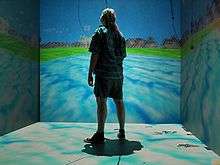Electronic Visualization Laboratory
The Electronic Visualization Laboratory (EVL) is a cross-disciplinary research lab at the University of Illinois at Chicago. It brings together faculty and students from the Art and Computer Science departments of UIC. The primary areas of research are in computer graphics, high-performance computer networking, and technological art.
History
EVL represents one of the oldest art and engineering collaborations in the United States. It was founded in 1973 by Tom DeFanti (then of the UIC Chemistry Department, later Computer Science) and Dan Sandin (of the Art Department). The lab was originally known as the Circle Graphics Habitat, in reference to the then-name of UIC, the University of Illinois at Chicago Circle. DeFanti and Sandin have served as Co-Directors of the lab since its founding. Later in 1987, they were joined by Maxine D. Brown as Associate Director.
Research


Work at EVL over the years has included:
- 1977: The Sayre Glove, the first dataglove.[1]
- 1981: The Z Box hardware and ZGRASS software (based on DeFanti's prior GRASS programming language), an early graphics system for the Bally home computer. This system featured NTSC video output and was used by a number of computer graphics artists of the time.
- 1988: Computer generated PHSColograms, an autostereoscopic 3D technique, with (art)n.
- 1992: The CAVE Automatic Virtual Environment, a projection-based virtual reality system.[2]
- 1995: The I-WAY event at Supercomputing '95, a prototype of grid computing.[3]
- 1997: The STAR TAP project, a linking up of several international high-performance networks. Followed by the StarLight optical networking facility.
Art
Highlights of the electronic art work done at EVL include:
- Electronic Visualization Events (EVE) in the mid 1970s - live, real-time performances featuring computer graphics, video processing, and music.
- Early computer graphics art videos, created by combining DeFanti's GRASS system on a PDP-11 and the Sandin Image Processor. The video Spiral PTL (1980) was included in the inaugural collection of video art at the Museum of Modern Art.
- Computer artist Larry Cuba spent time at EVL, using the tools there for his films 3/78 and Calculated Movements, as well as a short special effects sequence for Star Wars.
- In 1996, EVL installed the first publicly accessible CAVE at the Ars Electronica Center in Austria, and presented a number of virtual reality artworks.
SIGGRAPH
The members of EVL have been involved with the SIGGRAPH organization and conference ever since its inception. DeFanti has served as Secretary (1977-1981) and Chair (1981-1985) of the organization, and 1979 conference chair. Brown has served as Vice Chair for Operations (1985-1987) and Secretary (1981-1985), and chaired the 1992 conference. According to Jim Blinn, the popular Electronic Theatre "started out as a bunch of people crowding into Dan Sandin’s dorm room to watch videotapes." [4] In 1979, DeFanti established the SIGGRAPH Video Review, which EVL has continued to supervise. At SIGGRAPH '92, EVL organized the "Showcase" event, where researchers demonstrated 35 projects in state-of-the-art computational science and scientific visualization. At SIGGRAPH '94, EVL organized the VROOM event, demonstrations of the state of virtual reality technology.
In 1998, Brown received the first ever SIGGRAPH Outstanding Service Award for her contributions to the organization. In 2000, DeFanti and EVL alumna Copper Giloth also received the Outstanding Service Award.
References
- ↑ Sturman, D.J.; Zeltzer, D. (January 1994). "A survey of glove-based input". IEEE Computer Graphics and Applications. 14 (1): 30–39. doi:10.1109/38.250916.
- ↑ Cruz-Neira, C.; Sandin, D.; DeFanti, T.; Kenyon, R.; Hart, J. "The CAVE: Audio Visual Experience Automatic Virtual Environment". Communications of the ACM. 35 (6): 65–72. doi:10.1145/129888.129892.
- ↑ DeFanti, T., Foster I., Papka, M., Stevens, R., Kuhfuss, T. "Overview of the I-WAY: Wide Area Visual Supercomputing". International Journal of Supercomputing Applications. 10 (2): 123–130. doi:10.1177/109434209601000201.
- ↑ Blinn, J. (1995). "How to Attend a Siggraph Conference". IEEE Computer Graphics and Applications. 15 (4): 86–88. doi:10.1109/38.391503.